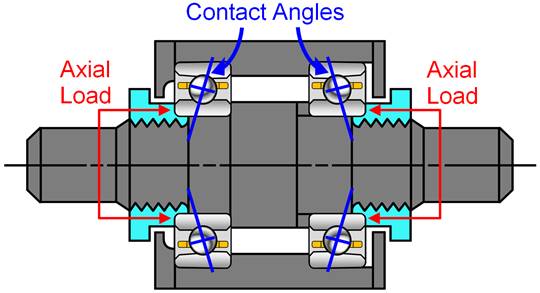Preloading Ball Bearings
Now that our full preload guide has been posted we’re compiling all of the information from this educational 5-part series into one, convenient location. Penned by AST’s VP of Operations, John Wallace, this guide has recently also been featured in Design World magazine and Bearingtips.com.

In the case of ball bearings, preload is often a misunderstood concept and overlooked by designers and bearing users alike.
One of the final steps in the bearing manufacturing process is the assembly of the individual bearing components: the outer ring, inner ring, balls and retainer (or ball separator). When the bearings are assembled, it is necessary to have a controlled amount of internal clearance, or looseness between the rings and balls. This is referred to as radial play in most bearing catalogs.
In certain applications, this internal clearance must be removed for a pair of bearings to operate properly. The application of an axial load across a pair of bearings – for the purpose of removing free internal clearances – is called preload.
What are the benefits of preloading ball bearings?
- Rotational accuracy and precise shaft positioning
- Elimination or reduction of ball skidding
- Control and reduction of axial and radial deflection under applied load
- Noise reduction
- Load sharing between bearings
Preload is critical in most high-precision and high-speed applications, particularly where rotational and positional accuracy is required.
If, under operating conditions, a bearing has radial play this means that one bearing race can be moved radially and axially relative to the other. With rotation, this looseness translates into wobble or non-repetitive runout. This motion is unacceptable in applications such as machine tool spindles, electric motors, optical encoders, flow meters, and high-speed hand tools.
The application of axial preload forces the balls into contact with raceways, establishing a contact angle which causes the ball set to rotate in a uniform circumferential plane.
Spring and Fixed Constraint Preloading
Spring preloading is simple, inexpensive, and should be a designer’s first consideration. Coil springs or wave spring washers are most commonly used, but a variety of spring types are available. The spring is used to press the races together, or apart.
Spring preloading provides a relatively constant preload because it is less sensitive to differential thermal expansion and can accommodate misalignment. Spring preloading uses a floating ring that reduces vibration levels transmitted from the bearings, making it a good choice in noise-sensitive applications. However, these types of assemblies will have minimal stiffness. Usually, the spring is positioned to push against the non-rotating ring.
Fixed constraint preload is achieved by mechanically fixing the “as-preloaded” position of the inner and outer rings of each bearing. This is commonly performed using the dead weight method. With dead weight preloading, adhesive is used to secure the rings in position while held in place with a weight equal to the specified preload amount. Once the adhesive has cured the weight is removed.
Axial Adjustment and Duplex Bearings
Axial adjustment requires great care, accuracy, proper tooling and cleanliness during the assembly process to avoid excessive preloading and ensure correct conditions. First, two bearings are mounted with the desired axial offset. The shaft and/or housing are threaded. Finally, the internal clearance in the bearings is removed by installing precision ground washers and then tightening the nut or threaded collar.
Duplex bearings are matched pairs of bearings with “built-in” preload. The inner or outer ring faces have been ground to a precise dimension known as the preload offset. This offset corresponds to the rings axial movement when a specific axial preload is applied. When the bearings are clamped together at assembly the offset faces abut, establishing a permanent, rigid preload in the bearing set.
Duplex bearings have increased radial and axial rigidity. There are three common preload configurations. DB (back-to-back) and DF (face-to-face) can handle bi-directional thrust loads. DT (tandem) can handle very heavy unidirectional thrust loads. At higher speeds, these bearings can run hotter due to the rigid preload. These bearings are commonly used in machine tool and other spindle applications, due to their low deflection rate, minimal runout and ease of assembly.
FAQ
How much preload should be applied?
In general, provided the design requirements are met, the least amount of preload is desired
What are the benefits of preload?
Rotational accuracy and precise shaft positioning, elimination or reduction of ball skidding, control and reduction of axial and radial deflection under applied load, noise reduction, load sharing between bearings
Does preload have any effect on a bearings operational life?
Bearing life decreases as preload is increased
What other side-effects of preload should I know about?
With increased or excessive preload, stresses are higher and excess heat is generated
Which preload method should be used?
Preload selection varies based on bearing type. For example, Miniature and thin section ball bearings have different internal geometry compared to larger radial and angular contact ball bearings. Be sure to follow the manufacturer’s guidelines, or consult with a bearing engineer.
What about preloading for machine tool spindles?
Machine tool spindles must be capable of resisting deflection from multiple directions while maintaining both rotational and positional accuracy. Duplex bearings with their high rigidity and accuracy are ideal for this application.
Part V, Final Considerations
Before deciding which preloading method to employ, designers should be aware of the following considerations and answer these questions:
- What is the desired or acceptable amount of deflection?
- What are the operating temperatures?
- Are there concerns with torque?
- Is there rapid acceleration or deceleration?
- Is the application torque sensitive?
- Is there moment loading or misalignment?
Armed with this information, preload options can be explored with a bearing expert.
Finally, as a general rule, a preloaded bearing assembly can only handle an axial load equal to approximately three times the preload amount. Beyond this load, one of the bearings in the pair will become unloaded and the deflection rate will equal that of a single bearing.

